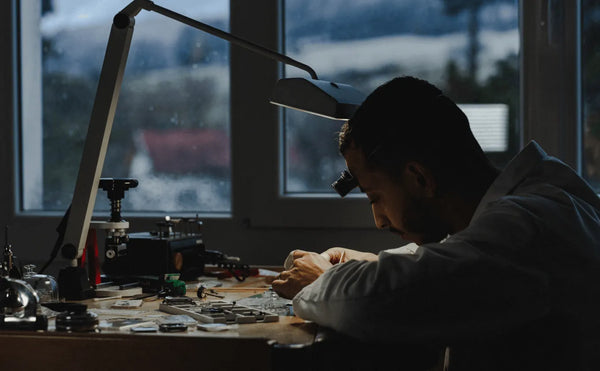You recently pre-ordered a Depancel and since you opted for quality, it will take three to six months before your watch gets to your wrist.
So, what happens during these months?
MAKING THE MOVEMENT

The first step is to make the motor. In watchmaking, this component is called a movement. There are quartz, mecha-quartz, manual and automatic movements.
While quartz and mecha-quartz watches run on a battery, you’re the one that keeps a mechanical watch running! With a manual mechanical watch, you need to wind the watch regularly using the crown to inject more energy into the mainspring. With automatic mechanical watches, your wrist movements keep the rotor continually turning, which winds up the spring.
If your watch has a mechanical movement, a watchmaker will meticulously assemble more than a hundred small parts so that your watch can tell you the time.
CRAFTING THE DIAL
This is the face of your watch. It enables you to correctly read all the information provided by the movement like the hours, minutes, seconds, day, month or 24-hour display. The dial is one of the first things that stands out when you look at a watch, which is why its design is so important. The dial is made in several stages and there are nearly endless opportunities for creativity with materials, finishes and colors.
The dial’s caseback is usually made with extremely precise machining equipment. Then a dial-maker takes over to finish the work manually. They create the apertures through which indications like the date can be seen and glue on or assemble the dial’s various decorations. This is an extremely meticulous profession that has existed for several centuries.
There are lots of possibilities when it comes to decorations and finishes, including
engraving, engine-turning (called guillochage), stippling, skeleton finishing (Pista GT), sunray (Serie-A Stradale), Côte de Genève or stamping (Offroad).

DESIGNING THE CASE

After artisans craft the movement and dial, it’s time to make the case for your watch. This is a very important part of your watch because it protects the movement from jolts, moisture and dust.
The case has several components: a main body that houses the movement and to which the horns are attached (for holding the strap), a bezel, which is a ring attached to the body that holds the crystal on, and the caseback, which is the watch’s back cover.
At Depancel, we use crystal casebacks whenever possible so you can admire your watch’s movement.
PUTTING EVERYTHING TOGETHER
The previous steps take a few weeks before everything arrives at the assembly stage. Once all the components are ready, our watchmakers carefully put them all together. They will first attach the dial to the movement’s plate, then slide on the hands. Both the alignment and height of the hands are important here. If they’re too close to the dial, they’ll touch the hour markers. Too far away and they’ll touch the crystal. Finally, the watchmaker puts the movement unit, the dial and the hands into the case.
CHECKING QUALITY
Just like a technical inspection before a race, our quality control step verifies that your timepiece and all its components meet our high quality standards. During this final step, we check all sides of the case, the dial, the crystal, the strap and the buckle assembly. Then we verify hand rotation and alignment, gauge functions and rotor rotation, making sure that all features of your watch work properly.And there you have it. Good things come to those who wait, so at the end of this three- to six-month process, you will have the pleasure of wearing a quality watch that comes with a five-year guarantee.
